It’s one for the coffee lovers this week – learn all about the wonders of Yemeni coffee beans and dive into the world of coffee with us, from its discovery to the darker chapters of its story. Read on to find out about the history hiding within your morning latte, and explore the delicious world of Arabic coffee with the incredible Medina Ilyas!
We’re even hosting a special Masterclass with Medina, where you can learn how to prepare Arabic coffee the traditional way and learn about the rituals and heritage behind this delicious drink. Join the masterclass for free when you subscribe to the Hump Day Newsletter – we’ll email you the details!
Yemeni Coffee
Across the Middle East, coffee is more than just a drink, it’s a cultural institution and a key part of that fabled Middle Eastern hospitality. It is the linchpin of social gatherings, and is served while entertaining guests, during business negotiations and of course at family occasions. In fact, it’s so important that UNESCO awarded Arabic coffee the designation of Intangible Cultural Heritage back in 2014.
Believe it or not, this all goes back to Yemen – the original home of coffee. For hundreds and hundreds of years, coffee has been cultivated in Yemen, and the delicious complexity of Yemeni Arabica beans is testament to the country’s long history and expertise in growing and processing this magical bean.
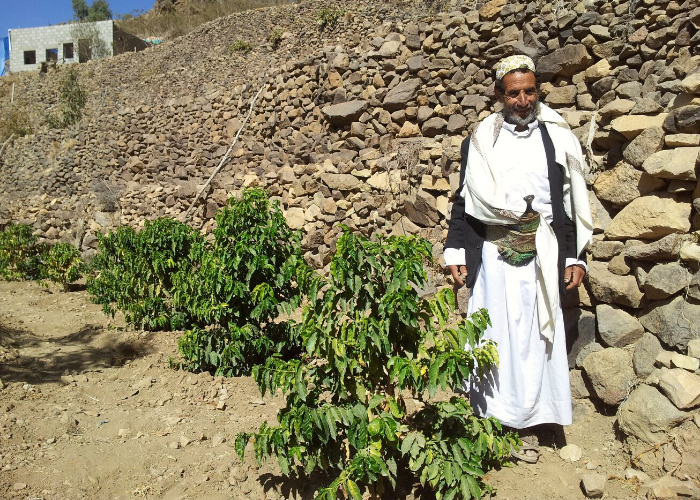
Yemeni coffee is considered the best coffee in the world thanks to its incredible flavour profile, buttery richness and depth, with notes of chocolate and a sweet fruitiness, with little of the bitterness that you sometimes find in other varieties. This marvellous drink warrants special care and attention in its preparation, and the rituals of preparing Arabic coffee do just that. A delight for all the senses, preparing Arabic coffee is a ceremony that grounds, connects and celebrates hundreds of years of heritage.
If you’d like to discover more about the ritual of preparing Arabic coffee, make sure you sign up to our *FREE* Arabic Coffee Masterclass hosted by Medina Ilyas of Medina Coffee, a coffee connoisseur who will be sharing her expertise and her secret recipe with us in a live, interactive class!
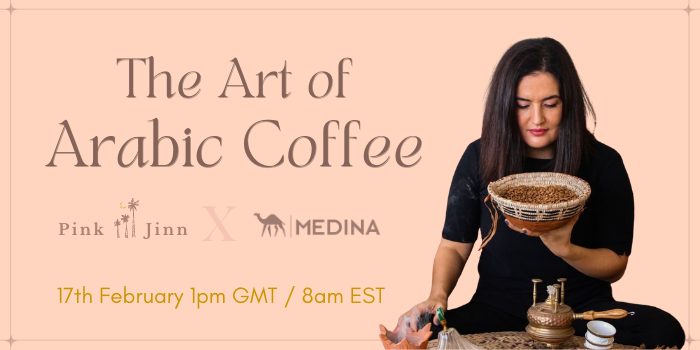
The Discovery of Coffee: Dancing Goats and Sufi Monks
More than a thousand years ago, coffee beans were known in Africa and the Middle East for their stimulating and fortifying properties. The legend goes that an Ethiopian goatherd named Kaldi, or perhaps Khalid, saw his goats prancing about after eating the berries of a wild bush and thought he would try them too. From Ethiopia the consumption of coffee beans spread to the Middle East, where it became especially popular among Sufi monks, who used the beans to stay awake and alert through long nights of prayer and while practising their devotions.
To begin with, coffee was consumed as the raw coffee cherry, either as an infusion or as a paste. Later the roasting process was discovered, and coffee as we know it was born. One myth is that a disapproving monk or imam, who frowned upon coffee’s stimulating properties, once threw some of the beans into a fire in an attempt to destroy them. Instead, an intoxicating aroma rose from the fire, and in a stroke of genius someone ground down the charred beans and turned them into a drink.
From then on, coffee was destined for worldwide stardom. The legendary 10th century Persian physician and scholar Ibn Sina (known in the West as Avicenna) even wrote about the fortifying properties of coffee in his famous encyclopaedia of medicine. It was soon discovered that the mountains of Yemen, on the southern coast of the Arabian Peninsula, provided the ideal climate for the coffee plant. Coffee growers carved terraces into the hillsides, where the plants flourished in the fertile soils and cooler temperatures of the mountains.
By the 13th century, Yemen was known as the home of coffee, and was the first place where the roasting and preparation of coffee was perfected. Especially in Islamic societies, coffee quickly took on an immensely important role, becoming the focus of social occasions and celebrations. Yemen’s proximity to the Islamic holy city of Mecca meant that trade routes and the Hajj pilgrimage quickly spread the popularity of coffee across the Islamic world and beyond into Asia and Europe.
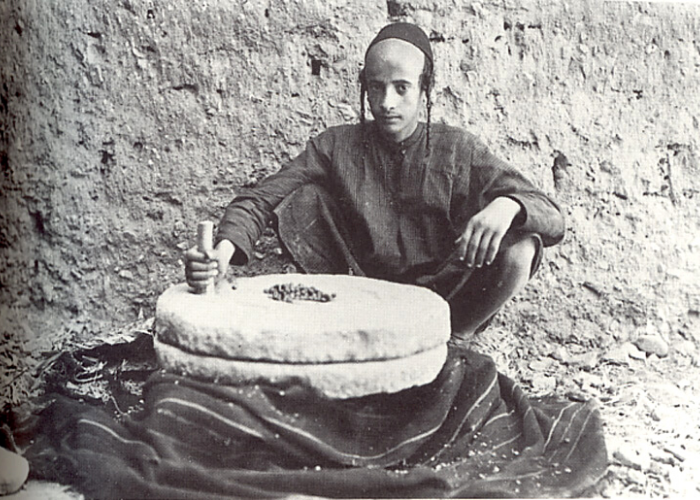
Empires and Smugglers
When the Ottoman Empire took control of Yemen in the 1530s, they recognised the huge potential of coffee as a trade commodity and production was expanded dramatically. Throughout the 16th century, almost every single cup of coffee consumed across the world was grown in Yemen and shipped out through the Yemeni port of Al Mokha (which gives its name to the drink!).
Unwilling to lose their control of this immensely lucrative trade, Ottoman rulers kept a vice-like grip on coffee cultivation, ensuring that every single bean was roasted or blanched before being exported to prevent them from germinating. This ensured that none of their clients could use the coffee beans to start their own plantations and disrupt the Ottoman coffee monopoly.
But when a single coffee bean has the potential to take down a mighty empire, even the best laid plans can fail. In the 17th century, a Sufi pilgrim from India by the name of Baba Budan visited Yemen while making the Hajj, the Islamic pilgrimage to Mecca. While there, the legend says that he stole 7 raw coffee beans, hiding them on his person to smuggle them out of Yemen. In one version of the story, he hides the beans in his beard to outwit officials, while in another, he wraps them in a cloth tied tightly around his stomach. With his secret cargo, Baba Budan returned to the Western Ghats of India, and planted them in the fertile soils of a crescent-shaped mountain range in Karnataka, which even today is known as the Baba Budan Hills.
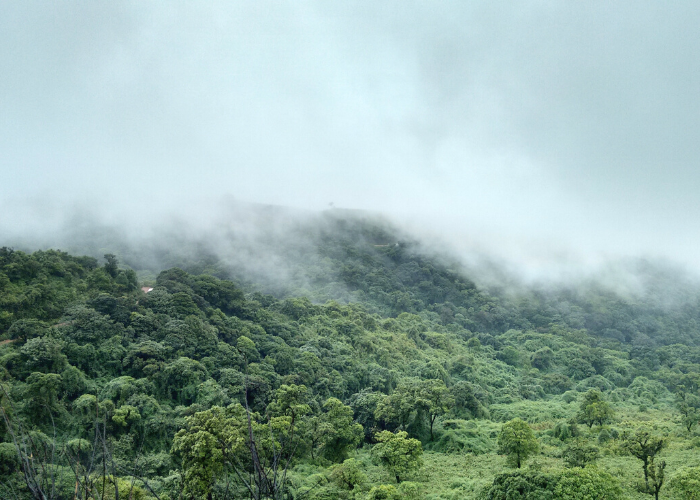
This broke the Ottoman monopoly and coffee cultivation quickly spread, not only in India, but in the Dutch East Indies. Dutch colonists quickly acquired coffee plants from the new Indian stock and set up plantations in Java, in modern-day Indonesia. The success of coffee cultivation in Java and elsewhere virtually destroyed the Yemeni coffee trade, and today only 1% of the coffee we drink comes from Yemen, despite Yemeni coffee being considered the best coffee in the world.
Revolutions and Exploitation: The Darker Side of Coffee
Coffee quickly took off in a dramatic way in Europe, with coffee houses springing up in huge numbers across London and Paris. Ale had previously been the most popular beverage, and was drunk throughout the day, understandably making people either rowdy or a bit drowsy. By contrast, this trendy new drink wasn’t intoxicating and was known for prompting stimulating conversation.
Popular with the likes of Isaac Newton, Voltaire, Samuel Pepys and Napoleon, coffee became the beverage of choice of the intelligentsia, to the point that in 1675, King Charles II of England attempted to ban coffee houses, fearing that they were brewing dissent as well as coffee. Historians have even posited that replacing ale with coffee as a common morning drink in Europe helped to spur on the Age of Enlightenment and revolution in France and Colonial America!

But the impact of the popularity of coffee in Europe goes far beyond its borders. Coffee was a major crop during the era of the slave trade along with sugar and tobacco, and the British and Dutch empires benefitted hugely from plantations in India, Sri Lanka and the Dutch East Indies. Although the days of empire are gone, the coffee trade today isn’t free of inequality or exploitation. More than 500 million people across the world work in the coffee trade, but with the invention of instant coffee and the rise of huge corporations like Nestlé and Starbucks, the profits mainly go to a tiny fraction of that number.
Over the last 50 years, the proportion of the retail cost of coffee that reaches the farmer who produced it has decreased dramatically. Since the 1970s, demand for lower prices has pushed the grower’s profits from the typical cup of coffee sold in Europe or the USA from 20% down to just 1-3%. And while Yemen is the historic home of coffee, bigger producers like Brazil, Indonesia and Colombia now dominate the market, making it harder for Yemeni coffee growers to sell their products. With the global coffee trade worth an estimated $102 billion and still growing, imagine the difference we could make if we all made sure our coffee farmers earned a fair profit!
If you’d like to experience Yemeni coffee for yourself, try our fair trade Yemeni Arabica coffee by Medina Coffee at the Pink Jinn Souq. Our single origin medium roast Arabica blend is accredited by the Specialty Coffee Association and is sustainably grown in Yemen and ethically sourced by Medina herself, who knows the farmers and their families personally and makes sure that they receive 65-75% of the proceeds of each of her sales. From selection to roasting, Medina pays painstaking attention to every detail that goes into producing her signature blends.
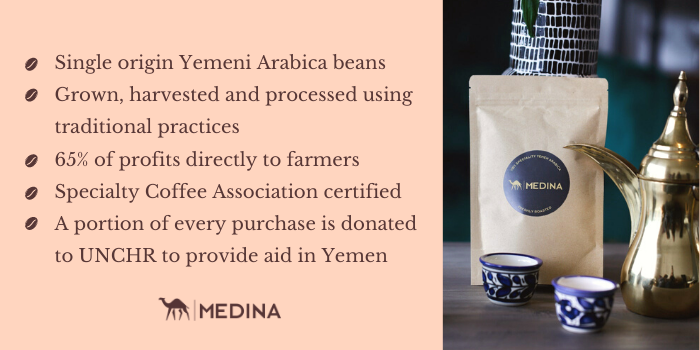
Have you tried Yemeni coffee before or seen how traditional Arabic coffee is prepared? Let us know in the comments if you’ve tried our Arabica blend!






